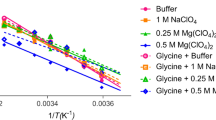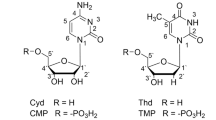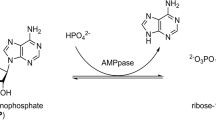Abstract
IN the course of purification studies of polynucleotide phosphorylase (polyase) from M. lysodeikticus we have on several occasions noticed that, after dialysis against buffers at low ionic strength or distilled water, considerable loss of enzyme activity occurred. With the addition of a salt such as sodium acetate or potassium chloride the activity of the enzyme was restored. The activation by potassium chloride of the polymerization of adenylic acid from adenosine diphosphate, determined by rate of release of orthophosphate at pH 9.5, is shown in Fig. 1. The optimum salt concentration is 0.2 M potassium chloride. Higher concentrations of the salt become inhibitory. Parallel studies based on the determination of polymer concentrations yielded identical results1. The following salts activate in the order: KCl > NaCl > Na2SO4 = HCOONa > CH3COONa > LiCl.
This is a preview of subscription content, access via your institution
Access options
Subscribe to this journal
Receive 51 print issues and online access
$199.00 per year
only $3.90 per issue
Buy this article
- Purchase on Springer Link
- Instant access to full article PDF
Prices may be subject to local taxes which are calculated during checkout
Similar content being viewed by others
References
Beers, jun., R. F., Nature, 177, 790 (1956).
Beers, jun., R. F., Biochem. J., [66, 686 (1957)].
Author information
Authors and Affiliations
Rights and permissions
About this article
Cite this article
BEERS, R. Activation of Polynucleotide Phosphorylase by Salts. Nature 180, 246–247 (1957). https://doi.org/10.1038/180246a0
Issue Date:
DOI: https://doi.org/10.1038/180246a0
This article is cited by
-
The isolation of polynucleotide phosphorylase from animal tissues
Bulletin of Experimental Biology and Medicine (1959)
-
Inhibition and Activation of Polynucleotide Phosphorylase through the Formation of Complexes between Acridine Orange and Polynucleotides
Nature (1958)
Comments
By submitting a comment you agree to abide by our Terms and Community Guidelines. If you find something abusive or that does not comply with our terms or guidelines please flag it as inappropriate.



